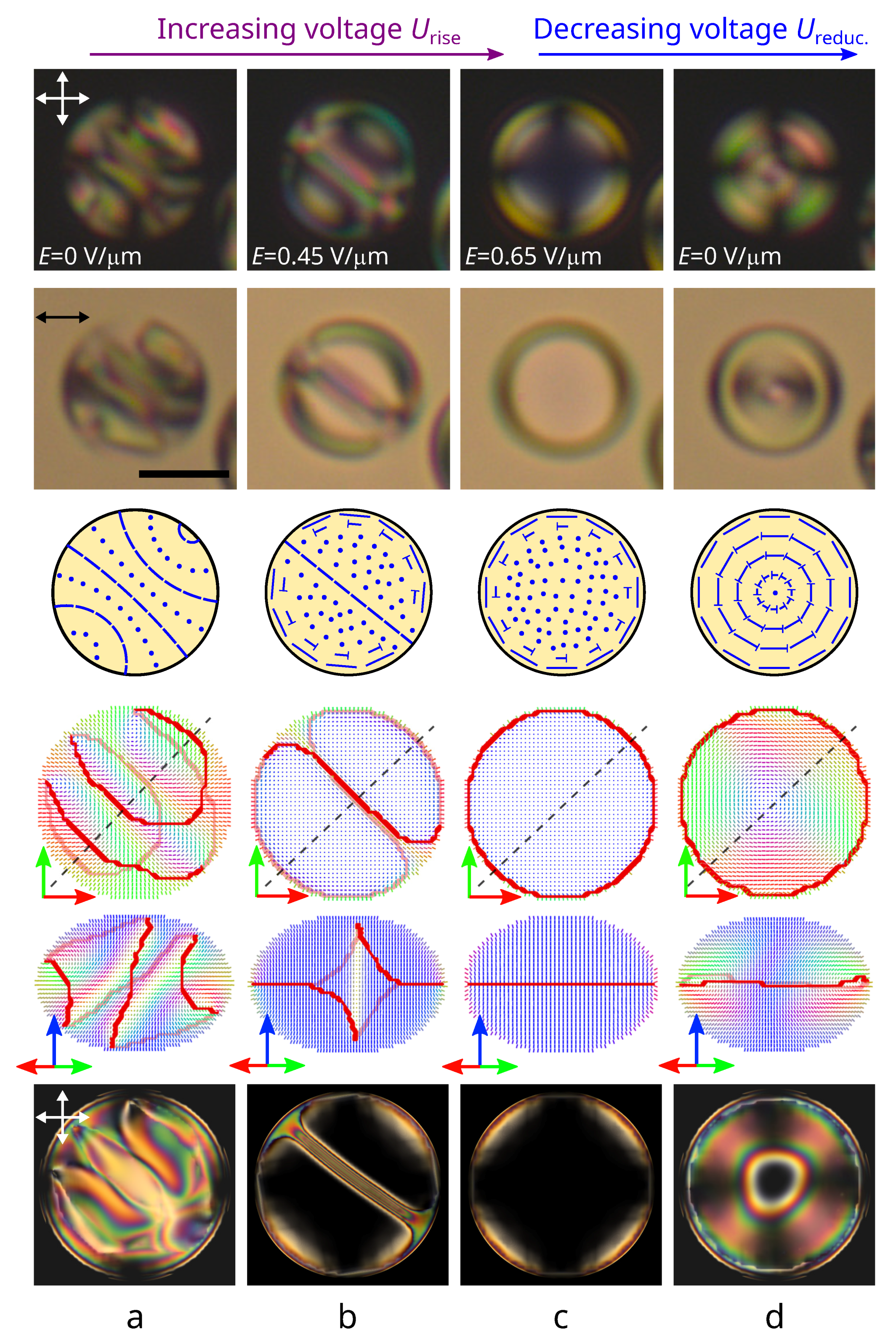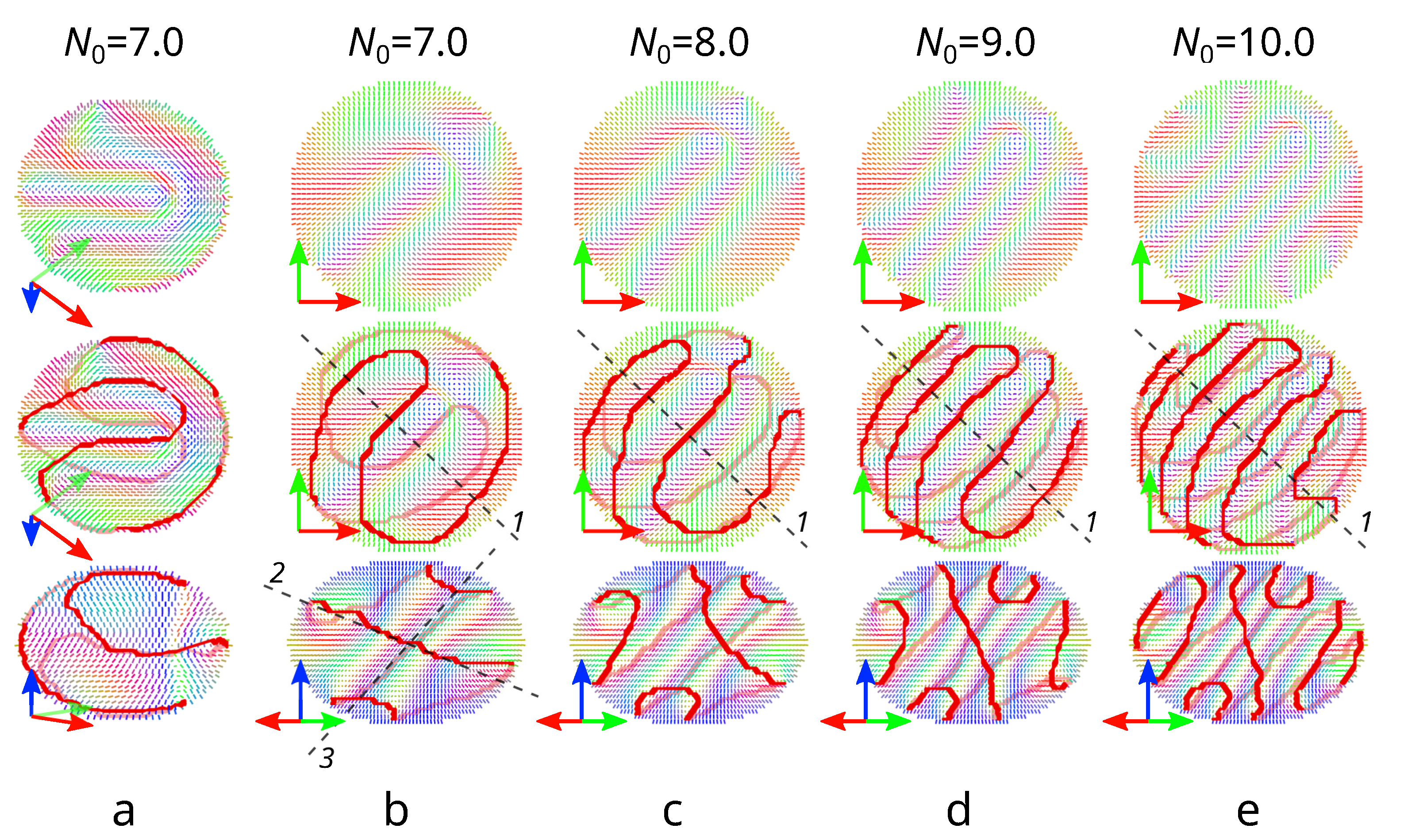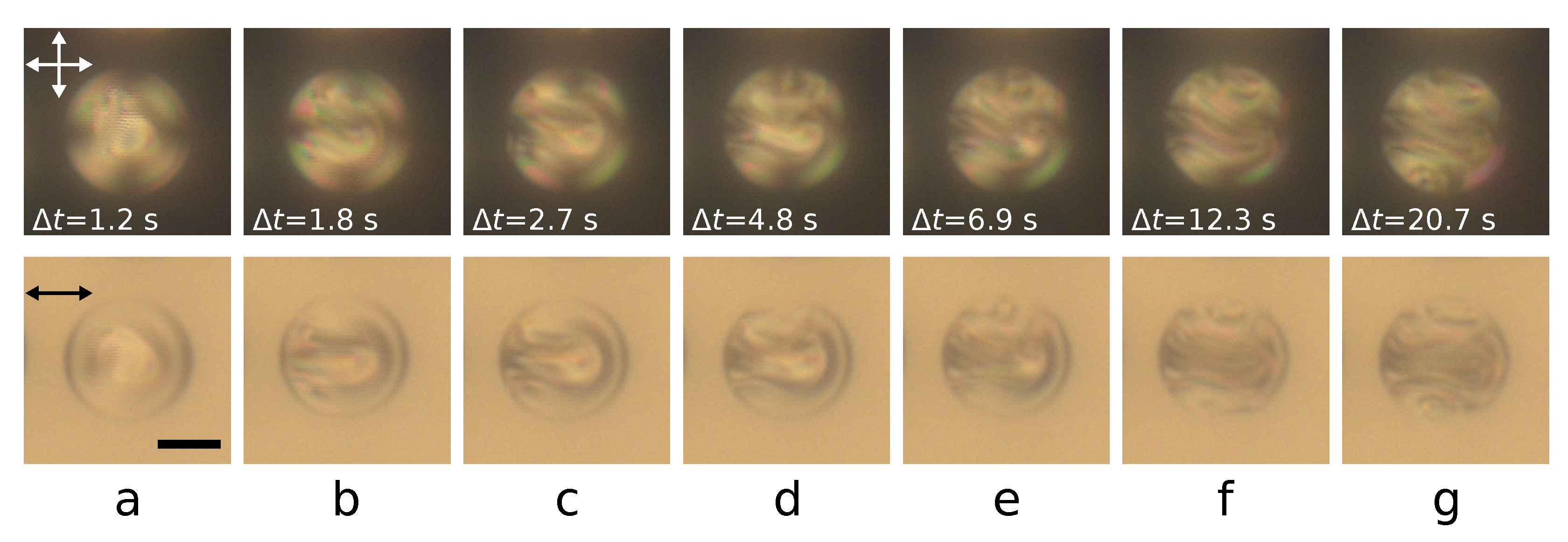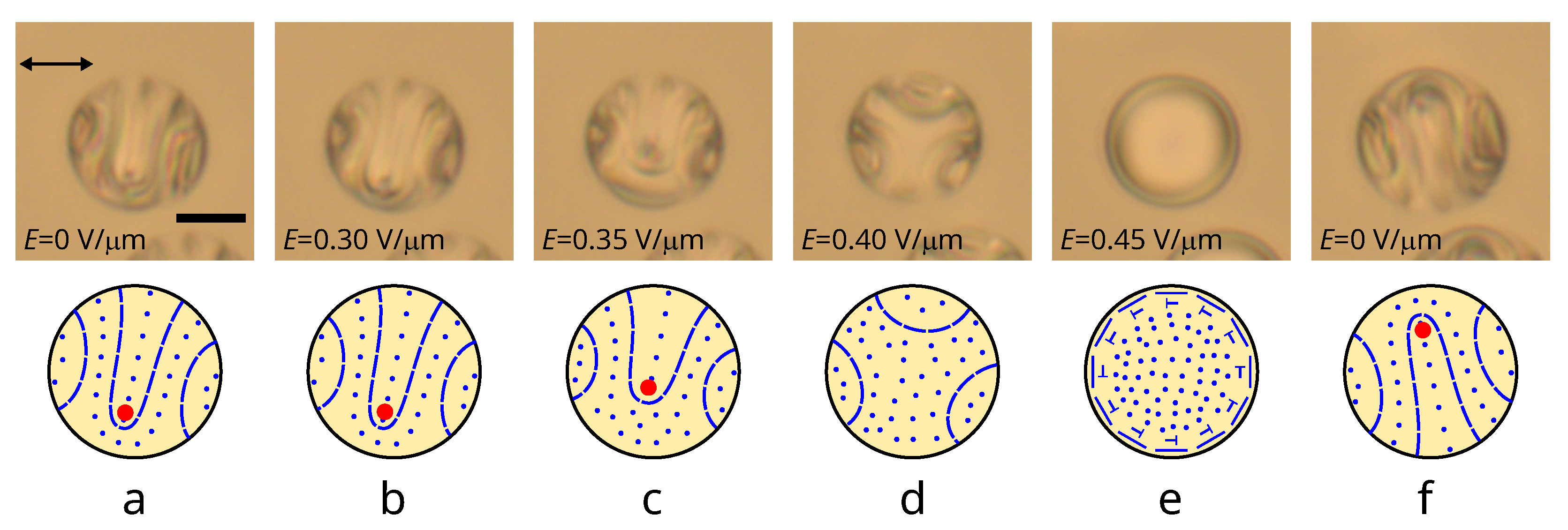Polymer-Dispersed Cholesteric Liquid Crystal under Homeotropic Anchoring: Electrically Induced Structures with λ1/2-Disclination
Abstract
:1. Introduction
2. Materials and Methods
2.1. Experimental Approaches
2.2. Computer Simulations
2.2.1. Calculations of the Droplet Structure
2.2.2. Calculation of the POM Textures
3. Results and Discussion
3.1. Transformation of the Initial Structure with a Bipolar Distribution of the Helix Axis
3.2. The Value of the Critical Electric Field
3.3. Formation Dynamics of the Layer-like Structure with -Disclination
3.4. Electric Field-Induced Transformation of a Structure with -Disclination
4. Conclusions
Supplementary Materials
Author Contributions
Funding
Institutional Review Board Statement
Informed Consent Statement
Data Availability Statement
Acknowledgments
Conflicts of Interest
References
- Yang, C.; Wu, B.; Ruan, J.; Zhao, P.; Chen, L.; Chen, D.; Ye, F. 3D-Printed Biomimetic Systems with Synergetic Color and Shape Responses Based on Oblate Cholesteric Liquid Crystal Droplets. Adv. Mater. 2021, 33, 2006361. [Google Scholar] [CrossRef]
- Belmonte, A.; Pilz da Cunha, M.; Nickmans, K.; Schenning, A.P.H.J. Brush-Paintable, Temperature and Light Responsive Triple Shape-Memory Photonic Coatings Based on Micrometer-Sized Cholesteric Liquid Crystal Polymer Particles. Adv. Opt. Mater. 2020, 8, 2000054. [Google Scholar] [CrossRef]
- Sadati, M.; Martinez-Gonzalez, J.A.; Zhou, Y.; Qazvini, N.T.; Kurtenbach, K.; Li, X.; Bukusoglu, E.; Zhang, R.; Abbott, N.L.; Hernandez-Ortiz, J.P.; et al. Prolate and oblate chiral liquid crystal spheroids. Sci. Adv. 2020, 6, eaba6728. [Google Scholar] [CrossRef]
- Belmonte, A.; Bus, T.; Broer, D.J.; Schenning, A.P. Patterned Full-Color Reflective Coatings Based on Photonic Cholesteric Liquid-Crystalline Particles. ACS Appl. Mater. Interfaces 2019, 11, 14376–14382. [Google Scholar] [CrossRef] [Green Version]
- Gao, Y.; Feng, K.; Zhang, J.; Zhang, L. Finger-Temperature-Detecting Liquid Crystal Composite Film for Anti-Counterfeiting Labels. Molecules 2020, 25, 521. [Google Scholar] [CrossRef] [Green Version]
- Wang, Y.; Li, H.; Zhao, L.; Liu, Y.; Liu, S.; Yang, J. Tunable whispering gallery modes lasing in dye-doped cholesteric liquid crystal microdroplets. Appl. Phys. Lett. 2016, 109, 231906. [Google Scholar] [CrossRef]
- Humar, M. Liquid-crystal-droplet optical microcavities. Liq. Cryst. 2016, 43, 1937–1950. [Google Scholar] [CrossRef]
- Zhang, Y.; Yuan, Z.; Qiao, Z.; Barshilia, D.; Wang, W.; Chang, G.E.; Chen, Y.C. Tunable Microlasers Modulated by Intracavity Spherical Confinement with Chiral Liquid Crystal. Adv. Opt. Mater. 2020, 8, 1902184. [Google Scholar] [CrossRef]
- Wang, C.; Gong, C.; Zhang, Y.; Qiao, Z.; Yuan, Z.; Gong, Y.; Chang, G.E.; Tu, W.C.; Chen, Y.C. Programmable Rainbow-Colored Optofluidic Fiber Laser Encoded with Topologically Structured Chiral Droplets. ACS Nano 2021, 15, 11126–11136. [Google Scholar] [CrossRef]
- Manna, U.; Zayas-Gonzalez, Y.M.; Carlton, R.J.; Caruso, F.; Abbott, N.L.; Lynn, D.M. Liquid crystal chemical sensors that cells can wear. Angew. Chem. Int. Ed. 2013, 52, 14011–14015. [Google Scholar] [CrossRef]
- Lee, H.G.; Munir, S.; Park, S.Y. Cholesteric Liquid Crystal Droplets for Biosensors. ACS Appl. Mater. Interfaces 2016, 8, 26407–26417. [Google Scholar] [CrossRef] [PubMed]
- Wang, Y.; Zhao, L.; Xu, A.; Wang, L.; Zhang, L.; Liu, S.; Liu, Y.; Li, H. Detecting enzymatic reactions in penicillinase via liquid crystal microdroplet-based pH sensor. Sens. Actuators B Chem. 2018, 258, 1090–1098. [Google Scholar] [CrossRef]
- Ailincai, D.; Pamfil, D.; Marin, L. Multiple bio-responsive polymer dispersed liquid crystal composites for sensing applications. J. Mol. Liq. 2018, 272, 572–582. [Google Scholar] [CrossRef]
- Lim, J.S.; Kim, Y.J.; Park, S.Y. Functional solid-state photonic droplets with interpenetrating polymer network and their applications to biosensors. Sens. Actuators B Chem. 2021, 329, 129165. [Google Scholar] [CrossRef]
- Oki, O.; Kulkarni, C.; Yamagishi, H.; Meskers, S.C.J.; Lin, Z.H.; Huang, J.S.; Meijer, E.W.; Yamamoto, Y. Robust Angular Anisotropy of Circularly Polarized Luminescence from a Single Twisted-Bipolar Polymeric Microsphere. J. Am. Chem. Soc. 2021, 143, 8772–8779. [Google Scholar] [CrossRef]
- Bezić, J.; Žumer, S. Structures of the cholesteric liquid crystal droplets with parallel surface anchoring. Liq. Cryst. 1992, 11, 593–619. [Google Scholar] [CrossRef]
- Seč, D.; Porenta, T.; Ravnik, M.; Žumer, S. Geometrical frustration of chiral ordering in cholesteric droplets. Soft Matter 2012, 8, 11982–11988. [Google Scholar] [CrossRef]
- Seč, D.; Čopar, S.; Žumer, S. Topological zoo of free-standing knots in confined chiral nematic fluids. Nat. Commun. 2014, 5, 3057. [Google Scholar] [CrossRef]
- Zhou, Y.; Bukusoglu, E.; Martínez-González, J.A.; Rahimi, M.; Roberts, T.F.; Zhang, R.; Wang, X.; Abbott, N.L.; De Pablo, J.J. Structural transitions in cholesteric liquid crystal droplets. ACS Nano 2016, 10, 6484–6490. [Google Scholar] [CrossRef]
- Krakhalev, M.N.; Rudyak, V.Y.; Prishchepa, O.O.; Gardymova, A.P.; Emelyanenko, A.V.; Liu, J.H.; Zyryanov, V.Y. Orientational structures in cholesteric droplets with homeotropic surface anchoring. Soft Matter 2019, 15, 5554–5561. [Google Scholar] [CrossRef]
- Gardymova, A.P.; Krakhalev, M.N.; Zyryanov, V.Y. Optical textures and orientational structures in cholesteric droplets with conical boundary conditions. Molecules 2020, 25, 1740. [Google Scholar] [CrossRef] [PubMed] [Green Version]
- Crooker, P.; Yang, D. Polymer-dispersed chiral liquid crystal color display. Appl. Phys. Lett. 1990, 57, 2529–2531. [Google Scholar] [CrossRef]
- Cipparrone, G.; Mazzulla, A.; Pane, A.; Hernandez, R.J.; Bartolino, R. Chiral self-assembled solid microspheres: A novel multifunctional microphotonic device. Adv. Mater. 2011, 23, 5773–5778. [Google Scholar] [CrossRef]
- Noh, J.; Liang, H.L.; Drevensek-Olenik, I.; Lagerwall, J.P. Tuneable multicoloured patterns from photonic cross-communication between cholesteric liquid crystal droplets. J. Mater. Chem. C 2014, 2, 806–810. [Google Scholar] [CrossRef]
- Fan, J.; Li, Y.; Bisoyi, H.K.; Zola, R.S.; Yang, D.k.; Bunning, T.J.; Weitz, D.A.; Li, Q. Light-directing omnidirectional circularly polarized reflection from liquid-crystal droplets. Angew. Chem. 2015, 127, 2188–2192. [Google Scholar] [CrossRef]
- Yang, C.; Wu, B.; Ruan, J.; Zhao, P.; Shan, J.; Zhang, R.; Yoon, D.K.; Chen, D.; Liu, K. Mechanochromic Responses of Cholesteric Liquid Crystal Droplets with Nanoscale Periodic Helical Structures Showing Reversible and Tunable Structural Color. ACS Appl. Polym. Mater. 2022, 4, 463–468. [Google Scholar] [CrossRef]
- Balenko, N.V.; Shibaev, V.P.; Bobrovsky, A.Y. Mechano-Optical Response of Novel Polymer Composites Based on Elastic Polyurethane Matrix Filled with Low-Molar-Mass Cholesteric Droplets. Macromol. Mater. Eng. 2021, 306, 2100262. [Google Scholar] [CrossRef]
- Orlova, T.; Aßhoff, S.J.; Yamaguchi, T.; Katsonis, N.; Brasselet, E. Creation and manipulation of topological states in chiral nematic microspheres. Nat. Commun. 2015, 6, 7603. [Google Scholar] [CrossRef] [Green Version]
- Posnjak, G.; Čopar, S.; Muševič, I. Points, skyrmions and torons in chiral nematic droplets. Sci. Rep. 2016, 6, 26361. [Google Scholar] [CrossRef]
- Posnjak, G.; Čopar, S.; Muševič, I. Hidden topological constellations and polyvalent charges in chiral nematic droplets. Nat. Commun. 2017, 8, 14594. [Google Scholar] [CrossRef]
- Biagio, R.L.; Souza, R.T.; Evangelista, L.R.; Zola, R.S. Frustrated structures and pattern formation after thermal quenches in cholesteric liquid crystal droplets. J. Mater. Chem. C 2021, 9, 8623–8639. [Google Scholar] [CrossRef]
- Pierron, J.; Tournier-Lasserve, V.; Sopena, P.; Boudet, A.; Sixou, P.; Mitov, M. Three-Dimensional Microstructure of a Polymer-Dispersed Liquid Crystal Observed by Transmission Electron Microscopy. J. Phys. II 1995, 5, 1635–1647. [Google Scholar] [CrossRef]
- Bouligand, Y.; Livolant, F. The organization of cholesteric spherulites. J. Phys. 1984, 45, 1899–1923. [Google Scholar] [CrossRef]
- Kitzerow, H.S.; Crooker, P. Electric field effects on the droplet structure in polymer dispersed cholesteric liquid crystals. Liq. Cryst. 1993, 13, 31–43. [Google Scholar] [CrossRef]
- Krakhalev, M.N.; Gardymova, A.P.; Prishchepa, O.O.; Rudyak, V.Y.; Emelyanenko, A.V.; Liu, J.H.; Zyryanov, V.Y. Bipolar configuration with twisted loop defect in chiral nematic droplets under homeotropic surface anchoring. Sci. Rep. 2017, 7, 14582. [Google Scholar] [CrossRef] [PubMed]
- Hernández, R.; Provenzano, C.; Mazzulla, A.; Pagliusi, P.; Viola, M.; Cipparrone, G. Cholesteric solid spherical microparticles: Chiral optomechanics and microphotonics. Liq. Cryst. Rev. 2016, 4, 59–79. [Google Scholar] [CrossRef]
- Yu, C.H.; Wu, P.C.; Lee, W. Electro-Thermal Formation of Uniform Lying Helix Alignment in a Cholesteric Liquid Crystal Cell. Crystals 2019, 9, 183. [Google Scholar] [CrossRef] [Green Version]
- Gardymova, A.P.; Krakhalev, M.N.; Zyryanov, V.Y.; Gruzdenko, A.A.; Alekseev, A.A.; Rudyak, V.Y. Polymer Dispersed Cholesteric Liquid Crystals with a Toroidal Director Configuration under an Electric Field. Polymers 2021, 13, 732. [Google Scholar] [CrossRef]
- Rudyak, V.Y.; Emelyanenko, A.V.; Loiko, V.A. Structure transitions in oblate nematic droplets. Phys. Rev. E 2013, 88, 052701. [Google Scholar] [CrossRef]
- Ondris-Crawford, R.; Boyko, E.P.; Wagner, B.G.; Erdmann, J.H.; Žumer, S.; Doane, J.W. Microscope textures of nematic droplets in polymer dispersed liquid crystals. J. Appl. Phys. 1991, 69, 6380–6386. [Google Scholar] [CrossRef]
- Li, J.; Wen, C.H.; Gauza, S.; Lu, R.; Wu, S.T. Refractive Indices of Liquid Crystals for Display Applications. J. Display Technol. 2005, 1, 51. [Google Scholar] [CrossRef]
- Gennes, P.G.d.; Prost, J. The Physics of Liquid Crystals, 2nd ed.; The International Series of Monographs on Physics; Clarendon Press: Oxford, UK, 1998. [Google Scholar]
- Guo, S.M.; Liang, X.; Zhang, C.H.; Chen, M.; Shen, C.; Zhang, L.Y.; Yuan, X.; He, B.F.; Yang, H. Preparation of a Thermally Light-Transmittance-Controllable Film from a Coexistent System of Polymer-Dispersed and Polymer-Stabilized Liquid Crystals. ACS Appl. Mater. Interfaces 2017, 9, 2942–2947. [Google Scholar] [CrossRef] [PubMed]
- Saeed, M.H.; Zhang, S.; Cao, Y.; Zhou, L.; Hu, J.; Muhammad, I.; Xiao, J.; Zhang, L.; Yang, H. Recent Advances in The Polymer Dispersed Liquid Crystal Composite and Its Applications. Molecules 2020, 25, 5510. [Google Scholar] [CrossRef] [PubMed]







Publisher’s Note: MDPI stays neutral with regard to jurisdictional claims in published maps and institutional affiliations. |
© 2022 by the authors. Licensee MDPI, Basel, Switzerland. This article is an open access article distributed under the terms and conditions of the Creative Commons Attribution (CC BY) license (https://creativecommons.org/licenses/by/4.0/).
Share and Cite
Gardymova, A.P.; Krakhalev, M.N.; Rudyak, V.Y.; Barbashov, V.A.; Zyryanov, V.Y. Polymer-Dispersed Cholesteric Liquid Crystal under Homeotropic Anchoring: Electrically Induced Structures with λ1/2-Disclination. Polymers 2022, 14, 1454. https://doi.org/10.3390/polym14071454
Gardymova AP, Krakhalev MN, Rudyak VY, Barbashov VA, Zyryanov VY. Polymer-Dispersed Cholesteric Liquid Crystal under Homeotropic Anchoring: Electrically Induced Structures with λ1/2-Disclination. Polymers. 2022; 14(7):1454. https://doi.org/10.3390/polym14071454
Chicago/Turabian StyleGardymova, Anna P., Mikhail N. Krakhalev, Vladimir Yu. Rudyak, Vadim A. Barbashov, and Victor Ya. Zyryanov. 2022. "Polymer-Dispersed Cholesteric Liquid Crystal under Homeotropic Anchoring: Electrically Induced Structures with λ1/2-Disclination" Polymers 14, no. 7: 1454. https://doi.org/10.3390/polym14071454
APA StyleGardymova, A. P., Krakhalev, M. N., Rudyak, V. Y., Barbashov, V. A., & Zyryanov, V. Y. (2022). Polymer-Dispersed Cholesteric Liquid Crystal under Homeotropic Anchoring: Electrically Induced Structures with λ1/2-Disclination. Polymers, 14(7), 1454. https://doi.org/10.3390/polym14071454






